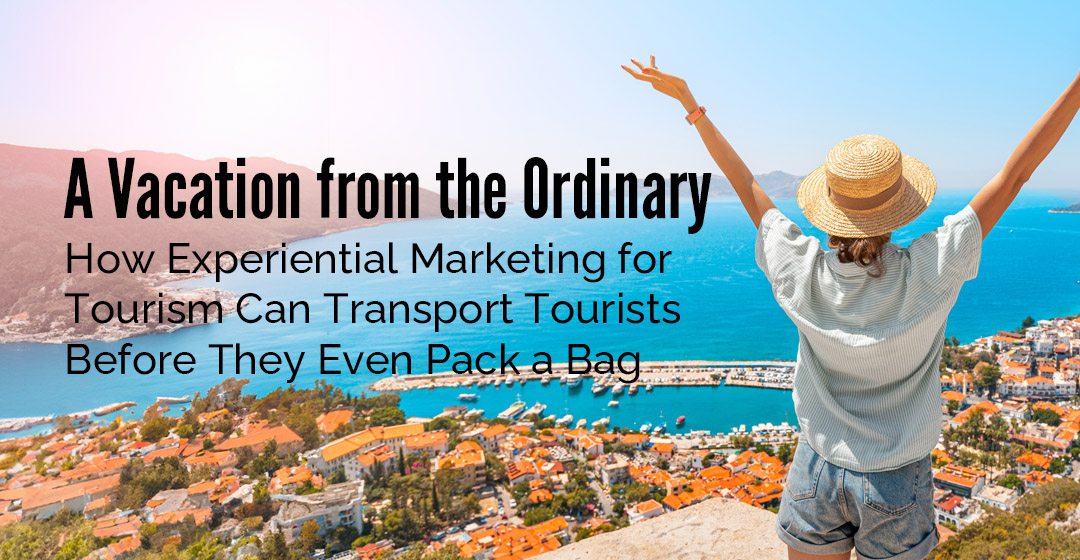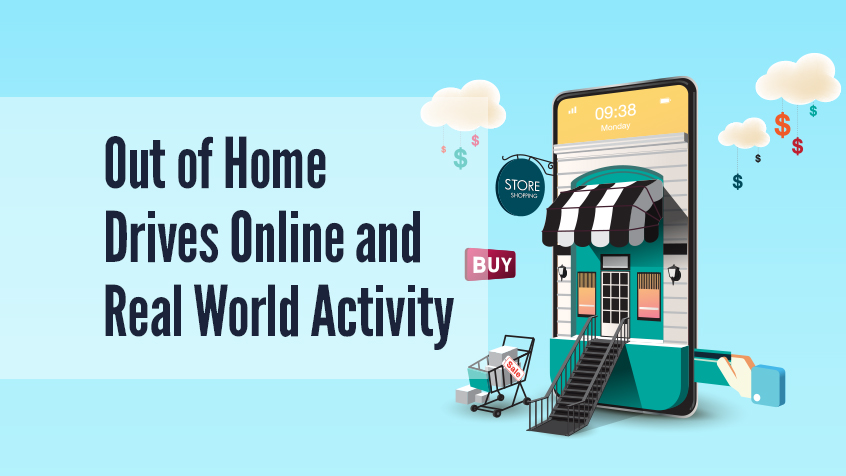In today’s fast-paced world, consumers constantly seek unique experiences that offer an escape. For tourists, this desire is amplified as they yearn for memorable moments that go beyond sightseeing and souvenirs.
According to a recent Forbes survey, “Americans took an average of 2.1 trips in 2023, with 36% of respondents traveling three or more times for leisure reasons.” The survey also showed that:
- 92% expect to travel at least as much in 2024 as 2023
- 45% plan to travel more in 2024
- 72% plan to spend over $2,000 in 2024
- 48% plan to spend over $4,000 in 2024
Experiential marketing for tourism, a dynamic marketing strategy that immerses consumers in branded experiences, has emerged as a powerful tool for engaging potential tourists and creating lasting impressions. Let’s explore how experiential activation can transport tourists to new destinations and ignite their wanderlust before they even pack a bag.
Setting the Scene:
Imagine this: You’re strolling down a bustling city street, surrounded by vibrant sights and sounds. Suddenly, you stumble upon a pop-up installation that whisks you away to a sun-drenched beach in the Caribbean or a bustling market in Marrakech (or Mount Rushmore). Instantly, you’re drawn into a new world, excited and eager to see it all, only to be left yearning for more. As you sink into your seat at your office, you fire up your laptop and immediately search resorts and flights to see how you could make the sample of what you just experienced a reality.

According to Conde Nast some of the top trends for travel in 2024 include things like Wild Feasting, Frontier Tourism, and Back of House Tours, all ideas that could beautifully translate to an Experiential Activation. Some other new trends include things like:
- Astro tourism
- Eco diving
- Sports tourism
- Cool-cationing
- Gig tripping
- Longevity Travel
- Private group travel
- Skip-gen travel
- Luxury Rail Trips
- Restaurateur-owned hotels
- Silent travel
- Urban gardens
This is the adventure of experiential activation – a journey that begins long before you board a plane or book a hotel room. Experiential activation is about creating unique, emotionally charged moments that stay with you, and ultimately pique your interest so much, you simply must experience the real thing IRL fully with a trip to the destination. Experiential marketing for tourism transports you to a place that feels real, allowing your imagination to run wild, and leaving you fantasizing about creating lifelong memories there.
Experiential Marketing for Tourism Creates Emotional Connections:
At its core, experiential activation is about more than just marketing products or services – it’s about forging emotional connections with consumers through a shared experience. For people looking to travel, these connections are particularly potent, as they evoke feelings of excitement, curiosity, and wanderlust.
Whether it’s a virtual reality tour of a far-flung destination or a taste of local cuisine at a pop-up restaurant, experiential marketing for tourism allow potential travelers to sample the culture and atmosphere of a place, forging a deep and lasting bond with the brand, and leaving them hungry for more. Our campaign with Visit Valley Forge for Date Night In Montco tapped into the desire for a date night that was local, but maybe overlooked.
This type of marketing is highly engaging and can create a lasting impact on tourists. Research by Accenture indicates that 91% of consumers are more likely to buy from brands that provide relevant and personalized experiences. Additionally, experiential activation can also be an effective way to build customer loyalty, as customers are more likely to remember a brand they have personally experienced.

Engaging the Senses:
One of experiential marketing’s key strengths is its ability to engage all five senses, creating a multi-dimensional experience that leaves a lasting impression. A report by Deloitte found that 78% of consumers prefer experiences over physical products, as they create more meaningful and memorable connections. From the aroma of exotic spices to the sound of traditional music playing in the background, every detail is carefully curated to transport tourists to another world.
Whether it’s a sensory garden that recreates the sights, sounds, and smells of a tropical rainforest or a virtual reality experience that lets visitors explore ancient ruins, experiential marketing for tourism appeals to the senses in ways that traditional marketing can’t match. Even smells can evoke strong emotions, as in the recent campaign for McDonalds. While it may not be tourism, even watching the video will make you crave fries.
Our campaign with Essential Costa Rica leveraged the senses with beautiful, iconic, oxcarts and the aroma and taste of Costa Rican coffee. This type of activation creates an immersive, lasting experience for consumers and encourages them to share their experiences with friends and family. Experiential activation can be a powerful marketing tool for businesses, helping to create an emotional connection between their brand and customers.
| Sense | Experiential Tactic |
| Sight | Tap into the culture’s color and design aesthetic. Use clothing, art, and iconic landmarks to bring the culture to life. |
| Sound | Use music local music and feature well-known artists from the culture. Feature live performances. Employ native language speakers to teach some key phrases. |
| Smell | Pump in the smell of food, spices, flowers, the beach or mountains. Offer take home scented souvenirs. |
| Taste | Share the flavors of the destination. Distribute samples of iconic dishes or employ chefs from the region to highlight the fine dining options available. |
Experiential Marketing for Tourism Fosters Community and Connection:
In today’s hyper-connected world, tourists crave authentic experiences that allow them to connect with local communities and cultures. Experiential marketing for tourism offers the perfect opportunity to foster these connections, bringing a destination’s unique culture to life in a way that builds connections. According to a report by the World Travel & Tourism Council, cultural tourism accounts for 39% of global tourism and is a key driver of economic development in local communities.
Experiential activations that highlight local culture and traditions can capitalize on this trend. Tourist destinations can use artists, chefs, and musicians from the destination who can not only demonstrate the culture but speak to it from first-hand experience. Our recent campaign for Visit Seattle highlighted this with their “I Know A Place” theme. It tapped into the travelers’ desire to have inside knowledge, that feeling of knowing about something special that only locals would know.
This provides a more meaningful experience, which is important for many travelers, particularly millennials who are actively seeking more “authentic” experiences when they travel. Experiential activations are an effective way to create a bridge between cultures and highlight those aspects that will be most appealing to travelers, leaving them wanting more.
Experiential Marketing for Tourism Drives Word-of-Mouth and Social Sharing:
In an age where social media reigns supreme, word-of-mouth marketing is more powerful than ever. Experiential activations are inherently shareable. They create surprising and unique experiences that people love to share. This serves two purposes.
First, the simple act of sharing increases the reach of the campaign, all those extra eyeballs on social are now exposed to the possibility of travel to the destination. Second, it can encourage other people in the area to check out the event. People are always looking for something to do, and when their friend share about the experiential pop-up they took in at the local park, it increases the size of the potential audience to participate.
Research by Stackla indicates that user-generated content is 9.8x more impactful than influencer content and 6.9x more impactful than brand-created content when it comes to influencing purchasing decisions. Experiential activations can leverage this trend. By harnessing the power of social sharing, experiential activation can amplify reach and engagement, turning potential tourists into brand ambassadors.

Measuring the Success of Experiential Marketing:
Of course, the ultimate goal of any marketing strategy is to drive tangible results. With experiential activation, success can be measured in various ways, from increased brand awareness and engagement to higher conversion rates and customer loyalty. Research has shown that experiential marketing campaigns can increase brand awareness by up to 65% and purchase intent by up to 85%
By tracking metrics such as website visits, bookings from key feeder markets, social media mentions, and customer feedback, brands can gain valuable insights into the effectiveness of their experiential activations and make data-driven decisions to optimize future campaigns.
This data can then be used to inform marketing strategies, target audiences, and to develop more effective campaigns. Additionally, it can help ensure that the right resources are being allocated to maximize effectiveness when using experiential marketing for tourism.
Book Your Trip Today:
In today’s competitive tourism landscape, brands must find innovative ways to capture travelers’ hearts and minds – before they book a flight or plan their next adventure. Experiential activation offers a powerful solution, allowing brands to transport tourists to new destinations and create unforgettable memories that leave them craving the real thing. How can experiential marketing do this for destinations and tourism?
- Create Emotional Connections: Place potential travelers in the middle of a memorable experience that creates a meaningful connection and yearning for more.
- Engage the Senses: Use flavors, sounds, and smells to evoke the impression of your destination.
- Foster Community and Connection: Create authentic cultural connections with the people and places that define your destination.
- Drive Word-of-Mouth and Social Sharing: Unique shareable moments amplify the campaign well beyond its activation and create a wealth of social content for the destination.
By engaging the senses, fostering community connections, and driving social sharing, experiential marketing for tourism can inspire wanderlust and ignite the imagination long before tourists even pack a bag. So, the next time you plan a marketing campaign, why not think outside the box and give tourists a vacation from the ordinary? With experiential activation, the possibilities are endless.





